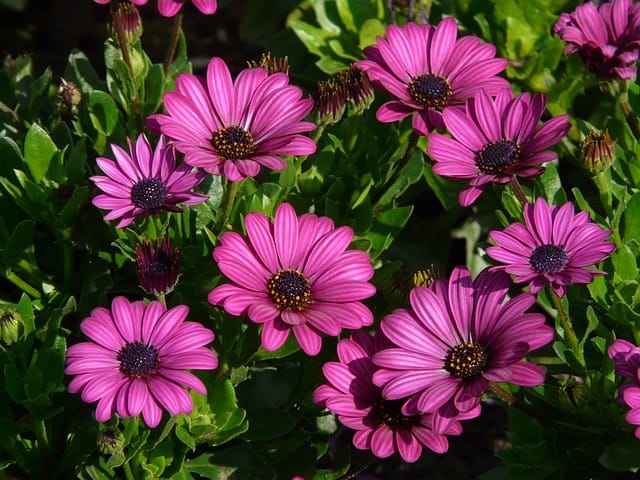How to grow Osteospermums
Welcome to our comprehensive guide on how to grow Osteospermums, also known as African daisies

In this article:
- Introduction
- Understanding Osteospermums
- Selecting the Right Varieties
- Choosing an Ideal Location
- Soil Preparation and Planting
- Watering and Irrigation Techniques
- Fertilizing and Nutrient Requirements
- Pruning and Deadheading Tips
- Pests and Disease Management
- Propagation Methods
- Overwintering Osteospermums
- Common Osteospermum Cultivars
- Creating Stunning Displays with Osteospermums
- Frequently Asked Questions
- Conclusion
Introduction
Welcome to our comprehensive guide on how to grow Osteospermums, also known as African daisies. These beautiful flowers are native to South Africa and are prized for their vibrant colors and daisy-like blooms. In this article, we will provide you with all the information you need to successfully grow and care for Osteospermums in your garden.
Understanding Osteospermums
Osteospermums belong to the Asteraceae family and are known for their daisy-like flowers. They come in a variety of colors, including purple, pink, orange, and white. These flowers bloom from spring to fall and are excellent additions to any garden or floral display.
Selecting the Right Varieties
When choosing Osteospermum varieties, consider factors such as flower color, size, and growth habit. Some popular cultivars include 'Serenity', 'Voltage Yellow', and 'Tradewind Pink Halo'. Select varieties that suit your personal preference and climatic conditions.
Choosing an Ideal Location
Osteospermums thrive in full sun, so it is essential to choose a location that receives at least six hours of direct sunlight per day. These flowers can tolerate a range of soil types, as long as the soil is well-draining.
Soil Preparation and Planting
Before planting Osteospermums, prepare the soil by removing weeds and adding organic matter. Dig a hole twice the size of the root ball and place the plant in the hole, making sure that the soil level matches that of the container. Fill the hole with soil and gently firm it around the plant.
Watering and Irrigation Techniques
Proper watering is crucial for the healthy growth of Osteospermums. Water the plants deeply but infrequently to encourage strong root development. Avoid overwatering, as it can lead to root rot. Consider using drip irrigation or a soaker hose to deliver water directly to the roots.
Fertilizing and Nutrient Requirements
Feed Osteospermums with a balanced fertilizer every 4-6 weeks during the growing season. Choose a fertilizer with a ratio of 10-10-10 or 14-14-14. Follow the manufacturer's instructions for application rates. Additionally, consider adding organic matter, such as compost, to the soil to improve its fertility.
Pruning and Deadheading Tips
Regular pruning helps maintain the shape and health of Osteospermums. Pinch back the stems to encourage bushier growth and remove spent flowers to promote continuous blooming. Pruning should be done in early spring or late fall.
Pests and Disease Management
Osteospermums are generally resistant to pests and diseases. However, they may occasionally be affected by aphids, snails, or powdery mildew. Monitor your plants regularly, and if necessary, use appropriate insecticides or fungicides to control the infestation.
Propagation Methods
Osteospermums can be propagated through seeds, cuttings, or division. Collect seeds after the flowers have faded and plant them in well-draining soil. Take stem cuttings from healthy plants in spring or autumn and root them in a mixture of sand and compost. Division can be done when the plant becomes overcrowded.
Overwintering Osteospermums
In colder climates, Osteospermums are often grown as annuals. However, they can be overwintered indoors or in a greenhouse. Before the first frost, dig up the plants and pot them in containers with well-draining soil. Place them in a cool location with bright light, and reduce watering until spring.
Common Osteospermum Cultivars
Some popular Osteospermum cultivars include:
- 'Serenity'
- 'Voltage Yellow'
- 'Tradewind Pink Halo'
- 'Purple Sun'
- 'Whirligig'
Creating Stunning Displays with Osteospermums
Osteospermums can be used in various ways to create stunning displays in your garden. They are perfect additions to borders, rock gardens, containers, or hanging baskets. Consider mixing different colors and varieties for a visually appealing arrangement.
Frequently Asked Questions
Q: Can Osteospermums tolerate frost?
A: Most Osteospermum varieties are not frost-tolerant and should be protected in colder climates.
Q: How often should Osteospermums be fertilized?
A: Osteospermums should be fertilized every 4-6 weeks during the growing season using a balanced fertilizer.
Q: Can Osteospermums be grown in containers?
A: Yes, Osteospermums are well-suited for container gardening. Choose a container with good drainage and keep the plants watered and fertilized regularly.
Conclusion
With their stunning colors and easy care requirements, Osteospermums are a fantastic choice for any garden. By following the guidelines provided in this article, you can successfully grow and enjoy the beauty of these flowers. Experiment with different cultivars and display options to create a vibrant oasis in your outdoor space.
